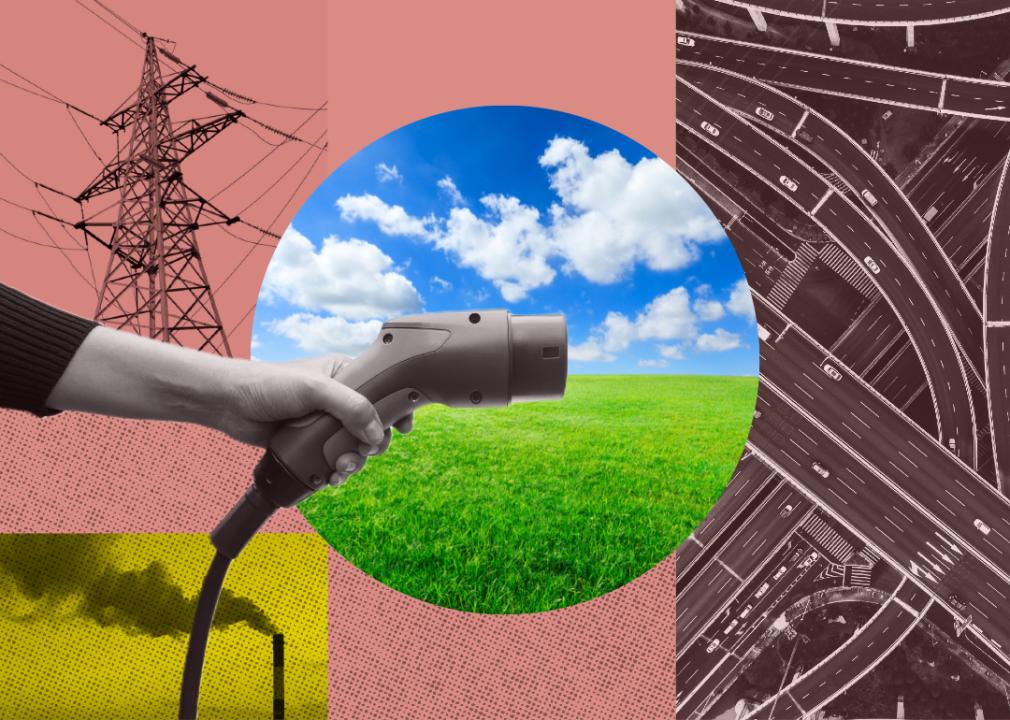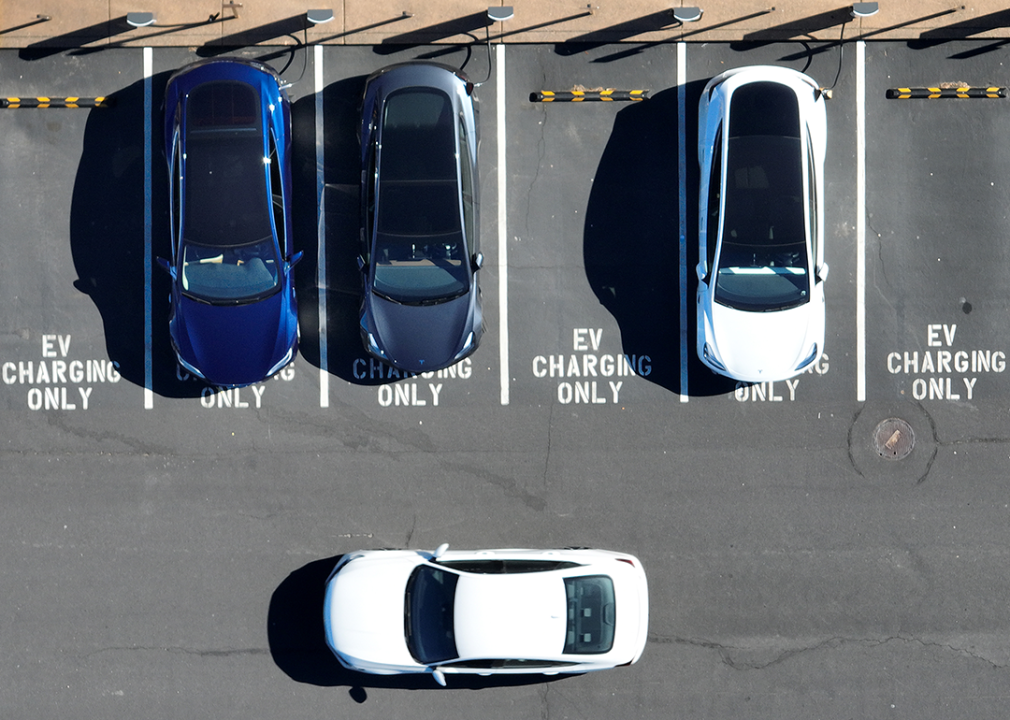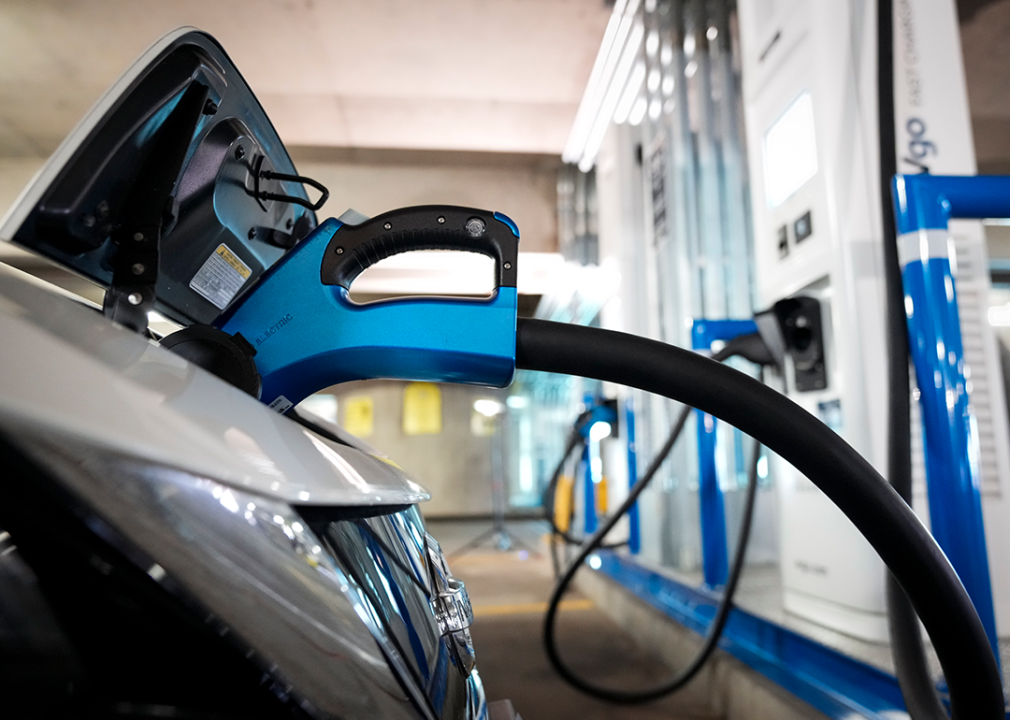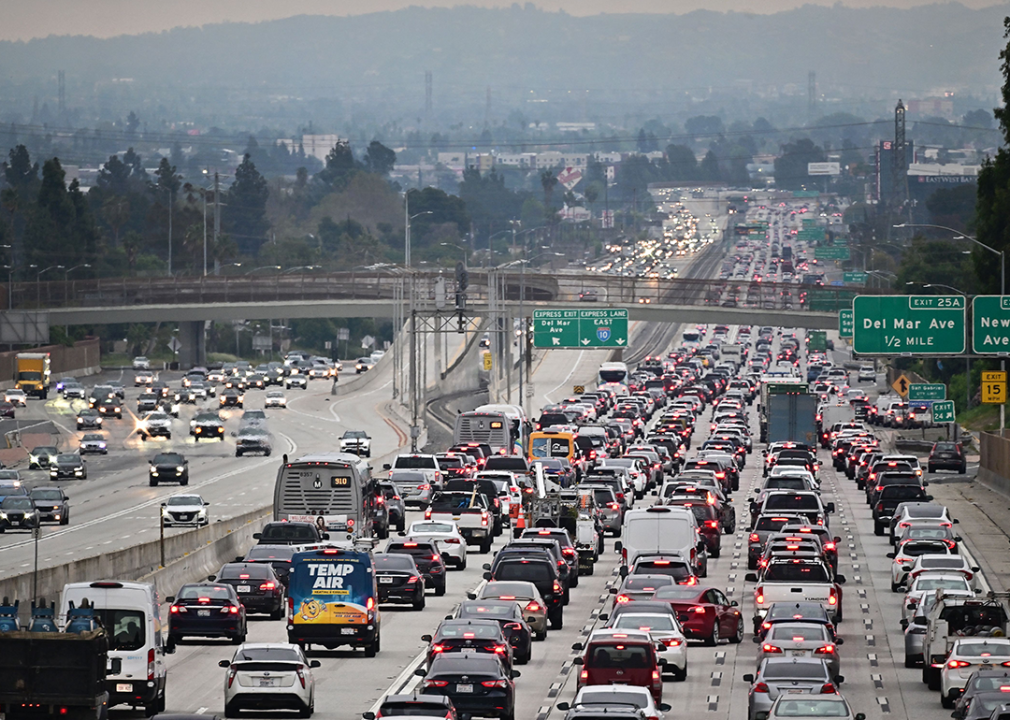Charging toward net zero: The environmental factors electric vehicles don't fix

Photo Illustration by Elizabeth Ciano // Stacker // Shutterstock
Charging toward net zero: The environmental factors electric vehicles don’t fix
Photo illustration with hand holding electric vehicle charger over a blue sky.
The U.S. has ambitious goals to curb climate change in the coming decades—and electric vehicles feature heavily in that plan.
EV vehicles represent an immense leap in automotive industry capabilities made possible by computer chips and battery technology advancements, further nudged by government incentives. But research and current economic and environmental trends have laid bare that they’re by no means a silver bullet for alleviating climate change.
CoPilot analyzed academic studies and federal and news sources to illustrate America’s uphill battle to electrify vehicles.
It’s a push that’s gotten off to a strong start. A record 1.2 million EVs were sold to consumers in 2023, according to Kelley Blue Book, representing a jump in overall sales from 5.9% in 2022 to 7.6% last year. In 2024, that share is projected to account for 10% of all vehicle sales.
To reach climate goals set for the end of the decade, however, the current pace of sales growth may prove insufficient.
Right now, the U.S. is focused on limiting global warming to 1.5 degrees Celsius. That means ensuring greenhouse gas emissions don’t reach the point where the world’s average surface temperature rises 1.5 degrees Celsius more than before the industrial era began in the early 1900s. Warmer global temperatures can melt arctic ice, raise sea levels, generate more extreme weather, and, as a result, endanger human life.
Transportation contributes 28% of the greenhouse gases driving climate change, making it the #1 contributor ahead of electricity generation and industrial production, per the Environmental Protection Agency. That means EVs could make a significant impact in lowering greenhouse gas emissions compared with other emissions-producing activities.
But groups pressing for climate change to be sufficiently addressed have warned that current U.S. policies may not be enough, highlighting the dire need to fast-track promising tech like EVs. The United Nations and a consortium of nonprofits working to curb climate change have warned that current U.S. policies are insufficient to meet 1.5-degree goals.
And that’s as reports suggest a recent slowdown in Americans’ appetites for the pricey, clean energy alternatives to their gasoline-burning vehicles.
![]()

Justin Sullivan // Getty Images
Signs are emerging that it will be difficult for automakers to hit EV climate goals
Aerial view of electric vehicles charging in parking lot.
The U.S. is pushing automakers to sell two EVs for every combustion-engine vehicle sold by 2032. It’s a regulatory goal that could reshape America’s auto industry in the most dramatic way since the birth of the combustion engine in the early 20th century.
Currently, they’re charting a roughly 2-3 percentage-point increase in sales each year. That figure could accelerate in the coming years as more than $120 billion in investments for assembly plants, infrastructure, and production come online, according to a report from the Environmental Defense Fund. For now, sales levels raise concerns about whether the goal proposed by the EPA is achievable. And automakers are raising other issues about their attempts to win over American consumers with electric vehicles.
For now, the vehicles are still remarkably expensive compared to their combustion-engine counterparts. Capital One research estimates the price premium on an average electric vehicle puts them out of reach for anyone earning less than around $120,000 per year.
Consumers are also anxious about how long it takes to charge an EV and how few charging stations are available. Federal subsidies aim to help private companies boost the number of charging stations in coming years, but developing faster-charging tech on par with the five-minute fill-up drivers can get at a gas station could take some time.

Drew Angerer // Getty Images
Plug-in EVs and hybrids still rely on burning coal
Cropped view of electric vehicle at charging station.
Then there are the sources of electricity available today, a mix of fossil fuels and renewables that augment each other’s weaknesses. When wind is sparse, natural gas fills in the gaps, keeping homes powered through the winter, for instance—likewise with solar energy.
Plug-in hybrids and EVs draw on the same power sources for electricity as our homes and businesses. Those sources still rely substantially on burning fossil fuels, including coal and natural gas. In 2022, about 60% of electricity in the U.S. was generated by fossil fuels, per the Energy Information Administration.
Still, EVs are significantly better for the environment, reducing emissions pollution by an entire half of that produced by gasoline-burning vehicles.

STR/AFP via Getty Images
EV battery production is not free of environmental consequences
Worker with aisles of batteries at a factory.
Where EVs lack a traditional engine, they have a massive battery at the vehicle’s base, providing the electricity needed so that powerful magnets can rotate the wheels. These forces are to thank for the near-instantaneous acceleration so many EV owners enjoy. But those batteries are made of hard-to-find resources like lithium, nickel, and cobalt.
EV detractors, including those in the fossil fuel industry, have criticized the inhumane labor practices used in parts of the world where these minerals are sourced. Building the batteries themselves involves a significant amount of pollution, something manufacturers are working to lessen.
It’s a phenomenon professor of technology and Guardian columnist John Naughton dubbed the “embedded carbon debt” of every EV purchase. It’s one that proponents of EVs hope will be lessened over time as a wide range of policies bring battery production, recycling, and mineral processing to the U.S. to be performed domestically.

FREDERIC J. BROWN/AFP via Getty Images
More vehicles, more asphalt
Traffic on a Los Angeles freeway during evening rush hour.
Much like our current predicament with combustion-engine vehicles, more EVs will require larger highways and additional roads. Expanding our existing roads and parking lots comes with its own environmental and societal downsides.
Highways can divide communities and make access to jobs and essential services difficult or cost-prohibitive. Asphalt exacerbates flooding, an issue projected to worsen with existing projections for climate change.
Despite the expansion of roadways more passenger vehicles necessitate, EVs still represent one of the most significant facets of a multipronged approach to curbing climate change. Especially given that American culture has become entrenched around personal passenger vehicles. Just 5% of the U.S. workforce uses public transportation to commute to work, according to the Census.
And the current presidential administration, backed by Congress, has plowed a historically large amount of taxpayer dollars into building out additional clean energy sources, EV charging infrastructure, and adding millions of new jobs to get it done.
Yet the question remains: Will it all be enough?
Story editing by Ashleigh Graf. Copy editing by Paris Close.
This story originally appeared on CoPilot and was produced and
distributed in partnership with Stacker Studio.





